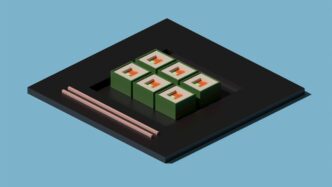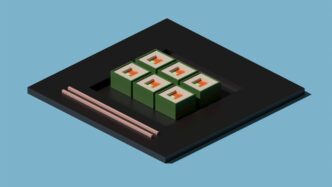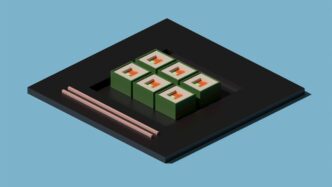Okay, so you’ve probably heard the buzz about quantum computers. They sound super futuristic, right? Well, Google just dropped a new chip called Willow, and it’s a pretty big deal in this whole quantum computing world. Forget your laptop; this thing is designed to tackle problems that are way, way too hard for even the best regular computers we have today. It’s like going from a bicycle to a rocket ship. Let’s break down what this google willow chip is all about and why it matters.
Key Takeaways
- The google willow chip represents a significant step forward in quantum computing, boasting a higher qubit count and improved performance over previous Google quantum processors.
- Willow demonstrated its computational power by solving a complex problem in minutes that would take current supercomputers an estimated 10 septillion years, though this specific task isn’t a real-world application yet.
- A major achievement of the google willow chip is its progress in quantum error correction, specifically demonstrating ‘below threshold’ capabilities where adding more qubits actually reduces errors, a critical hurdle for scaling quantum computers.
- Technical upgrades in Willow include longer qubit coherence times and lower overall error rates, making computations more reliable and bringing us closer to practical quantum systems.
- While still experimental, the google willow chip’s advancements pave the way for future applications in areas like drug discovery, materials science, energy, and quantum machine learning, though widespread practical use is still some time away.
Google’s Willow Chip: A Quantum Leap Forward

Alright, let’s talk about Google’s latest quantum chip, Willow. It’s a pretty big deal, honestly. Think of it as the next big step in trying to build those super-powerful quantum computers we keep hearing about. It’s not just a small upgrade; it’s a significant jump forward from what Google has done before. This chip is designed to tackle some seriously tough math problems, the kind that would make even the fastest regular computers we have today just give up.
Introducing the Willow Quantum Processor
So, what exactly is Willow? It’s Google’s newest quantum processor, and it’s built using superconducting technology. They announced it back in December 2024. This chip is a 105-qubit processor, which is a pretty good number in the quantum world. The main thing people are talking about is how fast it can do certain calculations. For a specific type of problem called random circuit sampling, Willow finished the job in less than five minutes. To give you an idea, Google figures the most powerful supercomputer out there would need about 10 septillion years to do the same thing. Yeah, you read that right. It sounds like something out of a movie, but it’s happening now.
Comparing Willow to Previous Google Quantum Chips
Google hasn’t just appeared out of nowhere with Willow. They’ve been working on this for a while. Before Willow, there was Sycamore, which came out in 2019. Before that, they had Bristlecone and Foxtail. Each chip has been a step up. Willow is notable because it has more qubits than Sycamore and, importantly, it’s showing much better performance, especially when it comes to handling errors. It’s like going from a bicycle to a sports car – both get you places, but one is a whole lot more advanced.
Here’s a quick look at how they stack up:
| Chip | Year | Qubit Count | Key Advancement |
|---|---|---|---|
| Foxtail | 2017 | (Not Specified) | Early exploration |
| Bristlecone | 2018 | 72 | Demonstrating quantum supremacy (for a task) |
| Sycamore | 2019 | 53 | Improved error rates, complex computations |
| Willow | 2024 | 105 | Enhanced error correction, speed, coherence |
The Significance of Willow’s Qubit Count
Having 105 qubits is a big deal for a few reasons. More qubits generally mean a quantum computer can handle more complex problems. It’s like having more workers on a construction site; more hands can get more done. But it’s not just about the number. The quality of those qubits and how well they work together matters a lot. Willow’s 105 qubits are designed to be more stable and less prone to errors than previous generations. This higher qubit count, combined with improvements in how errors are managed, is what allows Willow to tackle those incredibly difficult calculations that were previously out of reach.
Unpacking Willow’s Computational Prowess
So, what does Google’s Willow chip actually do that’s so special? It’s not just about having more qubits, though that’s part of it. The real story is how much faster and more reliably it can tackle certain kinds of problems that are practically impossible for even the biggest supercomputers we have today.
Willow’s Speed in Random Circuit Sampling
Imagine you have a really complicated maze. A classical computer tries every single path, one by one, until it finds the exit. A quantum computer, thanks to its weird quantum properties, can explore many paths at once. Willow is really good at a specific task called random circuit sampling. Think of it like generating a very complex, random pattern of quantum operations and then seeing what comes out. Willow can do this incredibly fast. Google says it finished a particular sampling task in about 5 minutes. That’s a blink of an eye in the grand scheme of computing.
Quantum vs. Classical Computing: A Speed Comparison
This is where things get mind-boggling. For that random circuit sampling problem, Google estimates that the most powerful supercomputer on Earth, like Frontier, would need an absurd amount of time to get the same result. We’re talking about numbers so big they’re hard to wrap your head around. It’s not just a little faster; it’s a whole different league.
| Task Type | Willow’s Time | Estimated Supercomputer Time |
|---|---|---|
| Random Circuit Sampling | ~5 minutes | ~10 septillion years |
This isn’t to say quantum computers will replace your laptop for everyday tasks like email or browsing. They’re specialized tools for specialized, incredibly hard problems.
The 10 Septillion Year Problem Solved
Let’s break down that 10 septillion year number. A septillion is a 1 followed by 24 zeros (1,000,000,000,000,000,000,000,000). So, the problem Willow solved in minutes would take the fastest classical supercomputer longer than the current age of the universe to complete. This massive speed difference highlights the potential of quantum computing to tackle problems that are currently completely out of reach. It’s like having a key to unlock doors we didn’t even know existed.
Breaking the Error Correction Barrier with Willow
Quantum computers are amazing, but they have this one big problem: errors. Qubits, the basic building blocks, are super sensitive. Think of them like a soap bubble – one wrong move and poof, the quantum magic is gone. For ages, this fragility has been the main roadblock, making it tough to build machines that can actually do complex tasks reliably. It’s like trying to build a skyscraper on jelly. But Google’s Willow chip? It’s changing the game.
The Achilles’ Heel of Quantum Computing
So, why are errors such a big deal in quantum computing? Well, qubits can get messed up by all sorts of things. Tiny vibrations, changes in temperature, even stray magnetic fields can knock them out of their delicate quantum state. This is called decoherence. When that happens, the calculations get messed up, and you end up with wrong answers. It’s a bit like trying to have a conversation in a rock concert – the noise just drowns everything out.
Willow’s ‘Below Threshold’ Error Correction
This is where Willow really shines. Google has managed to get its qubits to a point where adding more of them actually makes the system more stable, not less. They call this being "below threshold." Normally, more qubits mean more chances for errors to creep in. But with Willow, they’ve figured out a way to manage those errors so that the system gets better as it scales up. It’s a bit like how adding more people to a team can sometimes make the project run smoother, if everyone is working together right.
Exponential Error Reduction with Increased Qubits
What’s really wild is that Willow shows errors going down dramatically as they add more qubits. This isn’t just a small improvement; it’s an exponential drop. This means that as they build bigger and better quantum computers based on this tech, they can expect them to become incredibly accurate. It’s a huge step towards building quantum computers that can tackle really tough problems without getting bogged down by mistakes. This could look something like this:
- 100 Qubits: Moderate error rate, useful for some specific tasks.
- 500 Qubits: Significantly reduced error rate, opening up more complex calculations.
- 1000+ Qubits: Very low error rate, enabling large-scale, reliable quantum computations.
This ability to reduce errors while scaling up is what makes Willow such a big deal. It’s like finally finding a way to build that skyscraper on solid ground, no matter how tall you want to make it.
Inside Willow: Technical Advancements
So, what makes this Willow chip such a big deal? It’s not just about having more qubits, though that’s part of it. Google’s team has been busy tweaking and improving the underlying technology. They’ve been working on making the qubits themselves more stable and reliable, which is a huge hurdle in quantum computing. Think of it like trying to build a house on shaky ground – you need a solid foundation.
Boosting Qubit Coherence Times
One of the biggest challenges with quantum computers is that qubits lose their quantum state pretty quickly. This is called decoherence. Google has managed to significantly extend how long Willow’s qubits can hold onto their quantum information. They’ve boosted the coherence times by a factor of five, going from about 20 microseconds to 100 microseconds. In the quantum world, that’s a pretty massive improvement, giving the chip more time to actually do its work before errors creep in.
Slashing Overall Error Rates
Beyond just keeping qubits around longer, Google has also worked on reducing the mistakes that happen during calculations. Willow has seen its overall error rates cut in about half compared to its predecessor, the Sycamore chip. This means the results you get are more trustworthy. Fewer errors are obviously a good thing, making the computations more dependable.
The Custom-Built Nature of Willow
This isn’t a chip you can just buy off the shelf. Willow was built from the ground up in Google’s own specialized facility for making superconducting quantum chips. This custom approach allows them to fine-tune every aspect of the chip’s design and manufacturing process. It’s like a chef creating a unique dish with specially sourced ingredients, rather than just using what’s available at the local market. This bespoke nature is key to achieving the performance gains we’re seeing with the Willow quantum processor.
Here’s a quick look at some of the improvements:
- Extended Coherence: Qubits stay in their quantum state longer.
- Reduced Errors: Calculations are more accurate due to fewer mistakes.
- Specialized Manufacturing: Built with custom precision for optimal performance.
The Future Impact of the Google Willow Chip
So, what does this all mean, this whole Willow chip thing? It’s not just about Google building a faster calculator, though it certainly is that. We’re talking about tools that could genuinely change how we approach some of the biggest challenges we face. Think about it: problems that would take our current best computers longer than the universe has existed could potentially be solved in minutes.
Revolutionizing Drug Discovery and Materials Science
This is a big one. Imagine being able to perfectly model how a new drug interacts with the human body, down to the molecular level. That’s the kind of thing Willow could help us do. It means faster development of new medicines, and potentially, treatments for diseases we currently struggle with. It’s not just about drugs, either. We could design entirely new materials with properties we can only dream of today – think super-strong, lightweight alloys or materials that conduct electricity with zero resistance. This could really speed up innovation in so many areas.
Transforming Energy and Battery Design
Energy is another area where quantum computing, and Willow specifically, could make a massive difference. For instance, creating more efficient fertilizers for agriculture uses a lot of energy. Willow might help us find better ways to do that, cutting down on energy waste. And batteries? We all want better batteries for our phones and electric cars, right? Quantum computers could help us design batteries that charge faster, last longer, and hold more power. This is a huge step towards a more sustainable future.
Advancing Quantum Machine Learning
Machine learning is already changing the world, but quantum computers could take it to a whole new level. Willow’s ability to handle complex calculations could lead to much more powerful AI. This means smarter algorithms that can learn and adapt in ways we haven’t seen before. It could help us analyze massive datasets more effectively, leading to breakthroughs in fields like climate modeling or financial forecasting. The potential for quantum machine learning is enormous, and Google’s work with Willow is a key part of that journey.
Navigating the Road Ahead for Quantum Computing
So, Google’s Willow chip is pretty neat, right? It feels like we’re getting closer to those sci-fi movie scenarios. But let’s be real, it’s not like you’ll be downloading quantum apps on your phone next week. There are still some pretty big mountains to climb before quantum computers are doing our everyday chores.
Scaling Up Quantum Systems
Right now, we’re talking about hundreds of qubits. That sounds like a lot, but to really tackle the big problems, we’ll need millions. And it’s not just about cramming more qubits in; they have to be reliable. Think of it like building a skyscraper – you need a solid foundation, not just more floors piled on top. Getting these systems to grow without falling apart is a massive engineering puzzle. It’s like trying to keep a bunch of spinning plates in the air, but each plate is incredibly delicate.
The Challenge of Practical Applications
Even with super-powerful quantum computers, we still need to figure out what they’re actually good for. Sure, breaking encryption is a big one, and simulating molecules for new drugs sounds amazing. But beyond those headline-grabbing uses, finding everyday, practical problems that quantum computers can solve better than our current machines is still a work in progress. We’re still exploring the best quantum algorithms, the specific instructions that tell a quantum computer what to do. It’s a bit like having a super-fast race car but not having many race tracks to drive it on. We need more real-world scenarios where quantum advantage is clear. This is where research into quantum algorithms is so important.
Preparing for the Quantum Future
Even though widespread use is still a ways off, the world is already starting to get ready. Companies are looking into quantum-resistant encryption because, let’s face it, nobody wants their secrets exposed. It’s a bit like preparing for a storm by reinforcing your house before the rain even starts. The progress with chips like Willow means we can’t afford to wait. We need to start thinking about how our current systems will interact with future quantum machines and how we’ll train people to work with this new technology. It’s a mix of technical challenges and strategic planning. The infrastructure needed to support these machines is also a huge consideration; they require extreme cooling and shielding, making them massive energy consumers despite the efficiency of the quantum operations themselves. It’s a complex picture, but one that’s definitely worth paying attention to.
So, What’s Next?
Alright, so we’ve talked a lot about Google’s Willow chip, and it’s pretty mind-blowing stuff. It’s not like we’ll all have quantum computers on our desks next week, but this chip is a really big deal. It shows that the crazy ideas about quantum computing are actually becoming real, step by step. Think of it like this: we’ve gone from just dreaming about flying cars to actually building prototypes. Willow is one of those prototypes, proving that we can build these super-complex machines and make them work better, with fewer mistakes. It’s still early days, and there are plenty of challenges ahead, but Willow is a clear sign that the future of computing is going to be very different, and honestly, pretty exciting. We’re on the cusp of something new, and Google’s Willow chip is definitely leading the charge.
Frequently Asked Questions
What exactly is a quantum computer like Willow?
Think of a quantum computer as a super-specialized calculator, not just a faster version of your laptop. It uses tiny particles called qubits, which are way more flexible than the simple on/off switches (bits) in regular computers. This flexibility lets quantum computers tackle incredibly hard math problems that would take even the best supercomputers ages to solve.
How is Willow different from Google’s older quantum chips?
Willow is a big upgrade! It has more qubits, which are like the processing units in a quantum computer. More importantly, it’s much better at fixing errors that happen naturally in quantum systems. It also keeps its quantum ‘state’ for longer, which is crucial for doing complex calculations.
Why is fixing errors so important in quantum computing?
Quantum computers are super sensitive. Even tiny disturbances can mess up their calculations, kind of like a strong breeze knocking over a carefully balanced tower of blocks. Willow’s new technology helps fix these errors much more effectively, making the whole system more reliable and paving the way for bigger, more powerful quantum computers.
Can Willow solve problems that regular computers can’t?
Yes! For certain types of very complex problems, Willow is incredibly faster. It famously solved a problem in minutes that would take the world’s fastest supercomputers an estimated 10 septillion years! That’s a mind-boggling difference.
When will we have quantum computers we can use every day?
We’re not quite there yet. While Willow is a huge leap forward, building large-scale, reliable quantum computers for everyday tasks is still a big challenge. It will likely take many more years of research and development, but Willow shows we’re getting much closer.
What kind of real-world problems could quantum computers like Willow help solve?
The possibilities are exciting! They could help us discover new medicines, create amazing new materials, design better batteries for electric cars, and even improve artificial intelligence. It’s like having a powerful new tool to unlock scientific and technological breakthroughs.














